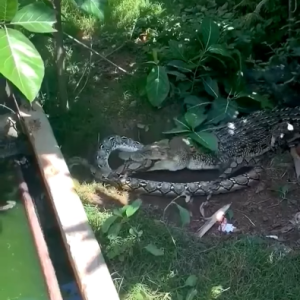High in the treetops of Borneo, there’s an ant with a deadly secret. It can explode.

On the outside, it’s just an inconspicuous, brownish-red ant. It lacks large mandibles, cannot sting, and generally seems like easy pickings for any predator with a rumbly in the tumbly.

But when these ants feel threatened, they raise up their rumps as a warning, says Alice Laciny, an entomologist with Natural History Museum Vienna in Austria who described the first new species of exploding ant since 1935 in the journal Zookeys.

Then, if the would be attacker a much larger weaver ant, say doesn’t back off, one or more tiny ants bite down on it, angle their backsides in close, and flex so hard that their abdomens burst at the seams. By tearing themselves apart, the ants sacrifice themselves to protect the rest of the colony.

Fittingly, Laciny and her coauthors named the new ant Colobopsis explodens, though the ability to blow up is not the species’ only interestingattribute. For one, when they explode, the ants unleash a secretion that is bright yellow, sticky, and toxic.

What’s more, Laciny says, this lethal yellow goo has a distinct and not unpleasant smell that’s strangely reminiscent of curry.

Ant For One and One For AntExploding ants have been known to science for more than a hundred years now, but they’re very rare, says Tomer Czaczkes, a behavioral ecologist specializing in ants at the University of Regensburg in Germany.

And while committing suicide to protect the colony seems a little extreme, it may make sense in the grand scheme of things.

Ants live in huge groups, says Czaczkes. This makes them an easy food source for innumerable predators.

It’s also why ants have evolved so many clever ways to defend themselves.

“Almost all ants can bite, sting, or spray formic acid,” says Czaczkes.

Some species, such as the turtle ants of Central and South America, can respond to danger by jumping off a branch and gliding back to a safe spot on the tree’s trunk. Others, like the trap-jaw ant, use their mandibles to catapult themselves to safety.

Self-sacrifice is also not unique to exploding ants, says Czaczkes. In fact, there’s a species of ant in Brazil that closes up its nests in the sand each night, presumably to prevent predators from finding the ants while they sleep.

But in order to remove all trace of the nest above the surface, between one and eight workers stay outside to seal up the entrance.

By dawn, most will be dead.

Hold the DoorAnother thing that’s unusual about exploding ants is their division of labor. Among most ants, the larger ants, or majors, do a lot of the defending and attacking.

So it’s curious that in C. explodens, the smaller ants, or minors, are the ones with the defensive chemicals.

“Majors are rarely seen in the wild, as they usually remain inside the nest,” says Laciny, who is also completing a Ph.D. at the University of Vienna.

But the big lugs aren’t totally useless. Indeed, Laciny and her colleagues found that the majors have plug-shaped faces which they use to become living doorstops, barricading the nest entrance if the minors and their detonating derrieres can’t repel an attacker.

In her future work, Laciny aims to unravel more mysteries about the exploding ants, such as what exactly goes into their signature yellow goo and how the ants use coordinated explosions to take down larger attackers.

Unfortunately, the trees that exploding ants call home survive in some of the few intact rainforests remaining on Borneo, places where it rains in amounts “unimaginable to a person from Central Europe,” Laciny says.

“And it’s never quiet,” she adds. “You either hear the sound of rain or the singing of cicadas, birds, screaming monkeys.”

“It is really like a different world!”

.

.






